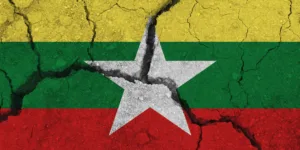Rising arms exports and strategic diplomacy could cement South Korea’s role in Europe’s defence sector.
Following the Russian invasion of Ukraine, South Korea has rapidly emerged as one of the top arms exporters to European countries. If it navigates Europe’s complex political landscape and maintains momentum in defence contracts, it has a unique opportunity to strengthen European ties and bolster its economy.
In the wake of the Russian invasion of Ukraine, South Korea quickly – and for some, surprisingly – emerged as one of the top providers of arms and ammunition to the European Union.
In 2022, European countries signed a record-breaking $8.4 billion worth of defence contracts with South Korea. By 2023, South Korea indirectly supplied more artillery shells to Ukraine than all European countries combined. This surge has positioned South Korea as the world’s tenth-largest arms exporter, and third-largest in Asia, after China and Israel.
Factors behind South Korea’s defence boom: Preparing for a land-based war
While some analysts see South Korea’s growing arms exports from a geopolitical perspective as part of the broader US-China great power competition, this angle overlooks other factors that are at play.
One of the main reasons contributing to its success lies in the South Korean defence industry’s strong positioning in the production of arms used in land-based war. The prevailing expectations of military strategists before the Russo-Ukrainian war were that future wars would mostly be asymmetric, centred on naval and air confrontations, with an increasing importance of cyber warfare. Large-scale ground invasions were considered a thing of the past. The production of weapons used in conventional interstate wars, such as artillery and missiles, had been scaled back in many countries.
However, South Korea’s precarious relationship with its northern neighbour necessitated that it maintain and advance its land warfare capabilities for both deterrence and defence purposes.
While South Korea is a major producer of ships and military aircraft, artillery and missiles thus remain central to its defence industry. This has in turn invited a lot of government investment and subsidies into the sector, which over time allowed domestic military producers to significantly expand production and achieve economies of scale.
Moreover, decades of technology transfers from Western countries, especially from the United States allowed South Korean military manufacturers to expand production and develop cutting-edge technology.
As a result, South Korean firms were well-positioned to capitalise on the surge in global demand for artillery, missiles and tanks after February 2022.
A promising path ahead for South Korea’s defence industry
While there has been a drop in orders following the peak of 2022, South Korea is in a good place to maintain the momentum.
Apart from its defence industry prowess, it can capitalise on the fact that it is regarded as a like-minded partner by the European Union. The efforts to decouple the global economy and split it into two competing camps do not seem realistic due to a high level of interdependence.
However, military matters are subject to much higher security scrutiny, and procurement from geopolitical competitors is often not an option. This shuts out some of the major arms producers from the European markets and strengthens Korea’s chances.
Importantly, while Korea is seen as a like-minded partner, it does not carry the same geopolitical baggage as the United States or other Western countries, which allows it to navigate politically complex markets more easily.
For example, countries like Slovakia, which maintains uneasy relationships with the EU and the US due to its open presentation as a partner for Russia and China, have still pursued arms deals with South Korea. Slovakia has long considered purchasing Korean-made anti-aircraft systems and concluded a strategic partnership in September this year. In other words, Korea’s allyship with the United States does not present challenges for its dealings with other countries.
Strategic diplomacy is key
To sustain this momentum, Korean diplomats must position their country in European capitals in such a way that defence orders keep flowing regardless of who is in power. This will require a level of diplomatic brinkmanship, an increasingly necessary strategy for countries hoping to transcend the US-China rivalry.
In the European context, this would entail developing an image of South Korea as a like-minded partner, while carefully balancing its messaging about ties to the US. In countries like Poland and the Baltic states, where deepening transatlantic relations is a priority, South Korea should highlight its close alliance with Washington.
On the other hand, in countries where public sentiment or government policies lean towards value-neutral or independent policymaking, such as Slovakia, the focus should be on South Korea’s competitive pricing, quality and ability to diversify procurement options.
Nevertheless, European countries would welcome the relocation of Korean defence production to their economies. Poland’s licensing of the production of Korean tanks sets a precedent for similar partnerships across the continent.
Seizing the window of opportunity
The war in Ukraine has opened a window of opportunity for South Korea to expand its defence exports and strengthen its strategic presence in Europe. While the rewards appear significant, sustaining this momentum will be challenging. The success of this approach relies on the ability of the country’s diplomats to operate with a high degree of diplomatic finesse and sensitivity.
Additionally, in the long term, these efforts could be undermined by renewed military tensions with North Korea, which would necessitate a shift in military production for domestic needs, ultimately reducing exports to Europe. A sudden and peaceful conclusion of the war in Ukraine or a defeat of Russia could also lead to a drop of demand from Europe, however, such turn of events seems highly improbable.
Nevertheless, owing to its strong strong arms manufacturing position and ideological closeness with Europe, and by capitalizing on its technological advantages and carefully navigating the political landscape, South Korea is in a strong position to seize a chance to enhance its relations with European countries while at the same time propelling its economy forward.
This article was produced as part of the project “De-risking and its challenges: Korean Positions in European Electromobility and Military Supply Chains after the Russian invasion of Ukraine,” funded by the Korea Foundation.
This article was originally published by Visegrad Insight.







